Greg Slabaugh
XFMamba: Cross-Fusion Mamba for Multi-View Medical Image Classification
Mar 04, 2025Abstract:Compared to single view medical image classification, using multiple views can significantly enhance predictive accuracy as it can account for the complementarity of each view while leveraging correlations between views. Existing multi-view approaches typically employ separate convolutional or transformer branches combined with simplistic feature fusion strategies. However, these approaches inadvertently disregard essential cross-view correlations, leading to suboptimal classification performance, and suffer from challenges with limited receptive field (CNNs) or quadratic computational complexity (transformers). Inspired by state space sequence models, we propose XFMamba, a pure Mamba-based cross-fusion architecture to address the challenge of multi-view medical image classification. XFMamba introduces a novel two-stage fusion strategy, facilitating the learning of single-view features and their cross-view disparity. This mechanism captures spatially long-range dependencies in each view while enhancing seamless information transfer between views. Results on three public datasets, MURA, CheXpert and DDSM, illustrate the effectiveness of our approach across diverse multi-view medical image classification tasks, showing that it outperforms existing convolution-based and transformer-based multi-view methods. Code is available at https://github.com/XZheng0427/XFMamba.
ADAPTER-RL: Adaptation of Any Agent using Reinforcement Learning
Nov 20, 2023



Abstract:Deep Reinforcement Learning (DRL) agents frequently face challenges in adapting to tasks outside their training distribution, including issues with over-fitting, catastrophic forgetting and sample inefficiency. Although the application of adapters has proven effective in supervised learning contexts such as natural language processing and computer vision, their potential within the DRL domain remains largely unexplored. This paper delves into the integration of adapters in reinforcement learning, presenting an innovative adaptation strategy that demonstrates enhanced training efficiency and improvement of the base-agent, experimentally in the nanoRTS environment, a real-time strategy (RTS) game simulation. Our proposed universal approach is not only compatible with pre-trained neural networks but also with rule-based agents, offering a means to integrate human expertise.
Joint Dense-Point Representation for Contour-Aware Graph Segmentation
Jun 21, 2023Abstract:We present a novel methodology that combines graph and dense segmentation techniques by jointly learning both point and pixel contour representations, thereby leveraging the benefits of each approach. This addresses deficiencies in typical graph segmentation methods where misaligned objectives restrict the network from learning discriminative vertex and contour features. Our joint learning strategy allows for rich and diverse semantic features to be encoded, while alleviating common contour stability issues in dense-based approaches, where pixel-level objectives can lead to anatomically implausible topologies. In addition, we identify scenarios where correct predictions that fall on the contour boundary are penalised and address this with a novel hybrid contour distance loss. Our approach is validated on several Chest X-ray datasets, demonstrating clear improvements in segmentation stability and accuracy against a variety of dense- and point-based methods. Our source code is freely available at: www.github.com/kitbransby/Joint_Graph_Segmentation
3D Coronary Vessel Reconstruction from Bi-Plane Angiography using Graph Convolutional Networks
Feb 28, 2023



Abstract:X-ray coronary angiography (XCA) is used to assess coronary artery disease and provides valuable information on lesion morphology and severity. However, XCA images are 2D and therefore limit visualisation of the vessel. 3D reconstruction of coronary vessels is possible using multiple views, however lumen border detection in current software is performed manually resulting in limited reproducibility and slow processing time. In this study we propose 3DAngioNet, a novel deep learning (DL) system that enables rapid 3D vessel mesh reconstruction using 2D XCA images from two views. Our approach learns a coarse mesh template using an EfficientB3-UNet segmentation network and projection geometries, and deforms it using a graph convolutional network. 3DAngioNet outperforms similar automated reconstruction methods, offers improved efficiency, and enables modelling of bifurcated vessels. The approach was validated using state-of-the-art software verified by skilled cardiologists.
Joint action loss for proximal policy optimization
Jan 26, 2023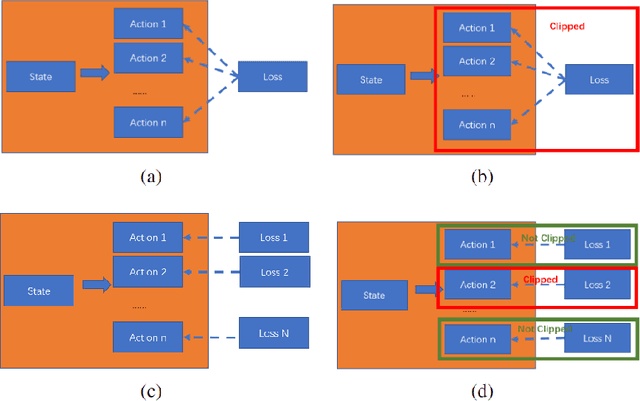
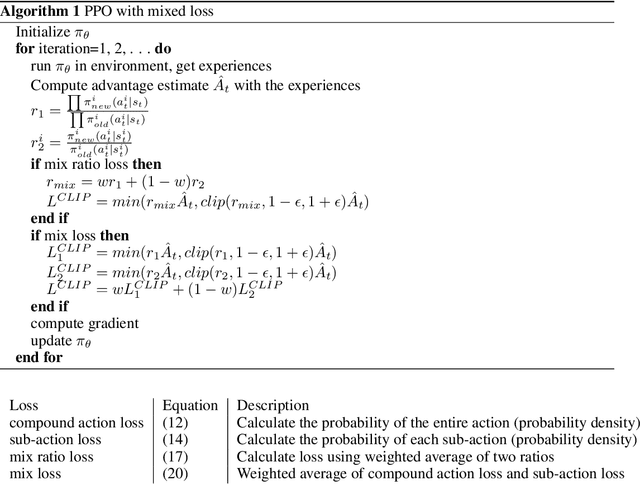
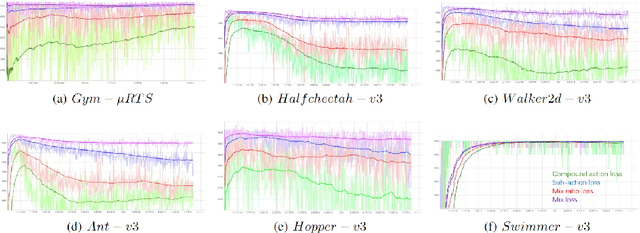
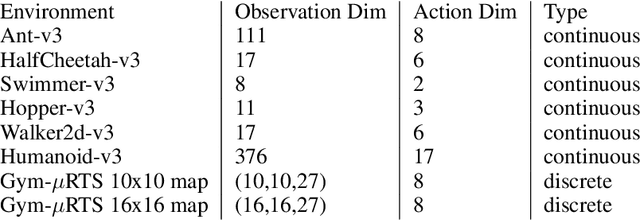
Abstract:PPO (Proximal Policy Optimization) is a state-of-the-art policy gradient algorithm that has been successfully applied to complex computer games such as Dota 2 and Honor of Kings. In these environments, an agent makes compound actions consisting of multiple sub-actions. PPO uses clipping to restrict policy updates. Although clipping is simple and effective, it is not efficient in its sample use. For compound actions, most PPO implementations consider the joint probability (density) of sub-actions, which means that if the ratio of a sample (state compound-action pair) exceeds the range, the gradient the sample produces is zero. Instead, for each sub-action we calculate the loss separately, which is less prone to clipping during updates thereby making better use of samples. Further, we propose a multi-action mixed loss that combines joint and separate probabilities. We perform experiments in Gym-$\mu$RTS and MuJoCo. Our hybrid model improves performance by more than 50\% in different MuJoCo environments compared to OpenAI's PPO benchmark results. And in Gym-$\mu$RTS, we find the sub-action loss outperforms the standard PPO approach, especially when the clip range is large. Our findings suggest this method can better balance the use-efficiency and quality of samples.
Partial advantage estimator for proximal policy optimization
Jan 26, 2023Abstract:Estimation of value in policy gradient methods is a fundamental problem. Generalized Advantage Estimation (GAE) is an exponentially-weighted estimator of an advantage function similar to $\lambda$-return. It substantially reduces the variance of policy gradient estimates at the expense of bias. In practical applications, a truncated GAE is used due to the incompleteness of the trajectory, which results in a large bias during estimation. To address this challenge, instead of using the entire truncated GAE, we propose to take a part of it when calculating updates, which significantly reduces the bias resulting from the incomplete trajectory. We perform experiments in MuJoCo and $\mu$RTS to investigate the effect of different partial coefficient and sampling lengths. We show that our partial GAE approach yields better empirical results in both environments.
PROPEL: Probabilistic Parametric Regression Loss for Convolutional Neural Networks
Jul 28, 2018



Abstract:Recently, Convolutional Neural Networks (CNNs) have dominated the field of computer vision. Their widespread success has been attributed to their representation learning capabilities. For classification tasks, CNNs have widely employed probabilistic output and have shown the significance of providing additional confidence for predictions. However, such probabilistic methodologies are not widely applicable for addressing regression problems using CNNs, as regression involves learning unconstrained continuous and, in many cases, multi-variate target variables. We propose a PRObabilistic Parametric rEgression Loss (PROPEL) that enables probabilistic regression using CNNs. PROPEL is fully differentiable and, hence, can be easily incorporated for end-to-end training of existing regressive CNN architectures. The proposed method is flexible as it learns complex unconstrained probabilities while being generalizable to higher dimensional multi-variate regression problems. We utilize a PROPEL-based CNN to address the problem of learning hand and head orientation from uncalibrated color images. Comprehensive experimental validation and comparisons with existing CNN regression loss functions are provided. Our experimental results indicate that PROPEL significantly improves the performance of a CNN, while reducing model parameters by 10x as compared to the existing state-of-the-art.
Fully Automatic Segmentation and Objective Assessment of Atrial Scars for Longstanding Persistent Atrial Fibrillation Patients Using Late Gadolinium-Enhanced MRI
May 26, 2017



Abstract:Purpose: Atrial fibrillation (AF) is the most common cardiac arrhythmia and is correlated with increased morbidity and mortality. It is associated with atrial fibrosis, which may be assessed non-invasively using late gadolinium-enhanced (LGE) magnetic resonance imaging (MRI) where scar tissue is visualised as a region of signal enhancement. In this study, we proposed a novel fully automatic pipeline to achieve an accurate and objective atrial scarring segmentation and assessment of LGE MRI scans for the AF patients. Methods: Our fully automatic pipeline uniquely combined: (1) a multi-atlas based whole heart segmentation (MA-WHS) to determine the cardiac anatomy from an MRI Roadmap acquisition which is then mapped to LGE MRI, and (2) a super-pixel and supervised learning based approach to delineate the distribution and extent of atrial scarring in LGE MRI. Results: Both our MA-WHS and atrial scarring segmentation showed accurate delineations of cardiac anatomy (mean Dice = 89%) and atrial scarring (mean Dice =79%) respectively compared to the established ground truth from manual segmentation. Compared with previously studied methods with manual interventions, our innovative pipeline demonstrated comparable results, but was computed fully automatically. Conclusion: The proposed segmentation methods allow LGE MRI to be used as an objective assessment tool for localisation, visualisation and quantification of atrial scarring.
Deep De-Aliasing for Fast Compressive Sensing MRI
May 19, 2017

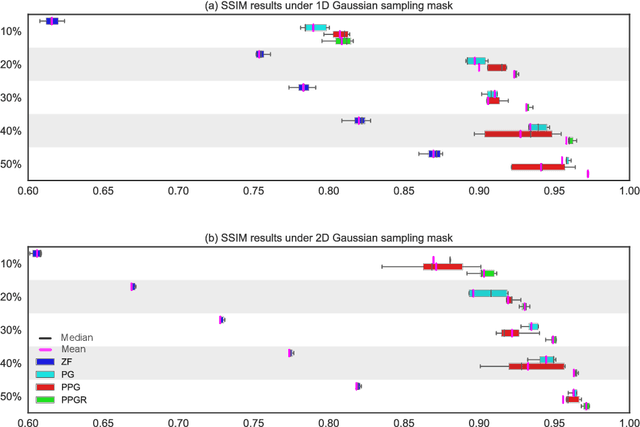
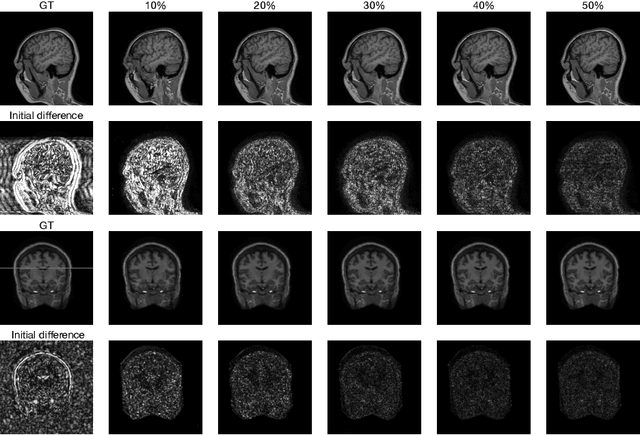
Abstract:Fast Magnetic Resonance Imaging (MRI) is highly in demand for many clinical applications in order to reduce the scanning cost and improve the patient experience. This can also potentially increase the image quality by reducing the motion artefacts and contrast washout. However, once an image field of view and the desired resolution are chosen, the minimum scanning time is normally determined by the requirement of acquiring sufficient raw data to meet the Nyquist-Shannon sampling criteria. Compressive Sensing (CS) theory has been perfectly matched to the MRI scanning sequence design with much less required raw data for the image reconstruction. Inspired by recent advances in deep learning for solving various inverse problems, we propose a conditional Generative Adversarial Networks-based deep learning framework for de-aliasing and reconstructing MRI images from highly undersampled data with great promise to accelerate the data acquisition process. By coupling an innovative content loss with the adversarial loss our de-aliasing results are more realistic. Furthermore, we propose a refinement learning procedure for training the generator network, which can stabilise the training with fast convergence and less parameter tuning. We demonstrate that the proposed framework outperforms state-of-the-art CS-MRI methods, in terms of reconstruction error and perceptual image quality. In addition, our method can reconstruct each image in 0.22ms--0.37ms, which is promising for real-time applications.
 Add to Chrome
Add to Chrome Add to Firefox
Add to Firefox Add to Edge
Add to Edge